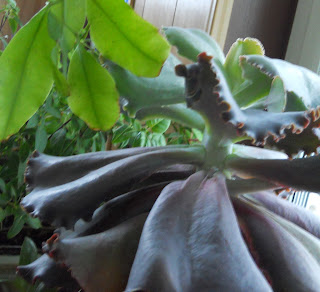 |
| Rose echeveria |
I grabbed hold of each of the leaves that weren't damaged in the fall and twisted them away from the stem, leaving a small piece of the stem attached to each leaf. These were set aside to dry and form a "callous" over the raw edge. That process will take anywhere from a couple days to a couple weeks, so I'll check my cuttings daily. When the raw edges are calloused over, I'll dip them in some rooting powder and lay them on top of dry cactus mix soil. The rooting powder may not actually encourage root development, but it does have anti-bacterial properties which help keep the cutting healthy. Then I'll place my pot of cuttings in a location with moderate temperature and normal light conditions. Drying out seems to encourage rooting in these succulents, so even though it seems counter-intuitive to everything I know about plants, I won't water the soil until the roots are well-developed in my new starts.
Within a couple months, I should see tiny pink roots beginning to form on top of the soil. Some of these roots are smart and find their way down into the soil themselves. Others need some gentle encouragement to dig into the soil. Eventually, new rosettes will form and can be transplanted into their new home.
I'll also lay the stem pieces on top of some dry potting soil and wait for tiny new rosettes to begin forming where the leaves had been attached. When these rosettes have four to six leaves, I'll use a sharp knife to cut the rosettes free of the old stem and plant them in their own pots.
The head of my echeveria is still nicely shaped and looks perfectly healthy. I'll trim all but about 2 to 3 inches of bare stem at the bottom of the rosette, allow the cut edge to callous over, dip the end in rooting powder, set the stem end of my echeveria "head" on dry potting soil and wait for new roots to form.
Evheveria tend to lose their bottom leaves as they grow. "Decapitating" it and planting the head will renew the plant, even if it hasn't crash landed on the floor.
Certainly not every leaf or stem cutting will produce roots and become a viable new echeveria. I am confident, though, that I will have at least enough plants to add some nice rose color to my succulent dishes this summer.

No comments:
Post a Comment